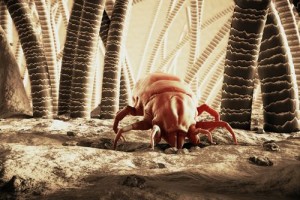Put your bedding under a microscope and you will discover colonies of dust mites. The average bed houses between 100,000 and 10,000,000 of them!
But don’t worry, dust mites are harmless. They are minuscule arachnids that consume only dead skin cells.
Unlike bed bugs, which are blood-feeding parasites, they do not bite, sting, or burrow into the skin. The only threat dust mites pose is to your respiratory system. Approximately 10% of Americans suffer from allergies related to a dust mite infestation.
What to Do about Dust Mites
Dust mites thrive in the bed because they require a moist, warm environment to flourish. Beds also provide an infinite food source, as we spend up to 1/3 of our lives sleeping and shedding. That said, dust mites sometimes prefer the carpets when pets live in the house. Anywhere with poor ventilation and high humidity also attracts them.
Clean Your Bedding Regularly to Control Dust Mites in Your Household
To control or eradicate the dust mites in your bed, launder your sheets every two weeks. Gather your sheets and pillowcases then throw them into a hot-water cycle.
Although hot water can cause the fibers in cloth to weaken, high heats kill dust mites most effectively. Moreover, drying the laundry can get rid of any mites that survived the wash.
Comforters and quilts often cannot withstand high temperatures. In most cases, washing in hot water encourages the colours to bleed. For this reason, use cold water and dry on low heat. Alternatively, bring your laundry to the dry cleaners.
Other Protective Measures
Since dust mites love the mattress, you could wrap it in plastic to stop them from making a habitat. Also, you could reduce the overall comfort of the room by placing an air purifier near the bed. Air purifiers reduce the amount of dust—and skin cells—floating in the air. Therefore, they prevent further food from settling on the beds and carpets.
Because carpets cannot go through the wash, you might want to invest in a steam cleaner. Steam removes dirt, germs, and bacteria and can get rid of dust mites and bed bugs.

